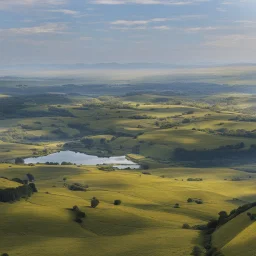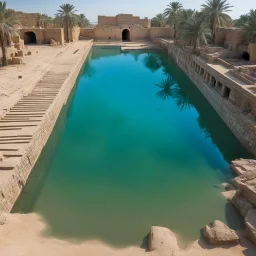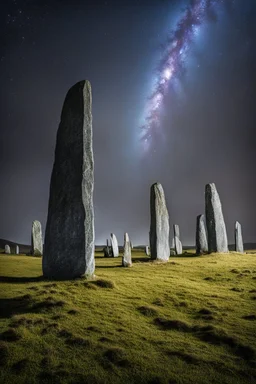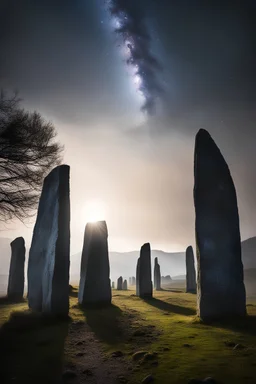![Placeholder: Close similarities have been noted between Stonehenge and Pömmelte circular enclosure in central Germany, which was built by Bell Beaker people around 2300 BC.[127] [121] Large timber circles in Britain such as Woodhenge, near to Stonehenge, have similarly been dated to the early Beaker period or just before the Beaker period.[182][183] Some researchers have suggested that Woodhenge may have been a monumental roofed building, though it is usually thought to have been an open-air structure.[184][](https://img.stablecog.com/insecure/64w/aHR0cHM6Ly9iLnN0YWJsZWNvZy5jb20vMDEwZmRlNTYtNDFiMC00Mzc0LWE1ODktZDA0ZTMxOTdhOGMxLmpwZWc.webp)
![Close similarities have been noted between Stonehenge and Pömmelte circular enclosure in central Germany, which was built by Bell Beaker people around 2300 BC.[127] [121] Large timber circles in Britain such as Woodhenge, near to Stonehenge, have similarly been dated to the early Beaker period or just before the Beaker period.[182][183] Some researchers have suggested that Woodhenge may have been a monumental roofed building, though it is usually thought to have been an open-air structure.[184][](https://img.stablecog.com/insecure/1920w/aHR0cHM6Ly9iLnN0YWJsZWNvZy5jb20vMDEwZmRlNTYtNDFiMC00Mzc0LWE1ODktZDA0ZTMxOTdhOGMxLmpwZWc.webp)
@generalpha
Prompt
Close similarities have been noted between Stonehenge and Pömmelte circular enclosure in central Germany, which was built by Bell Beaker people around 2300 BC.[127] [121] Large timber circles in Britain such as Woodhenge, near to Stonehenge, have similarly been dated to the early Beaker period or just before the Beaker period.[182][183] Some researchers have suggested that Woodhenge may have been a monumental roofed building, though it is usually thought to have been an open-air structure.[184][
statue, doubles, twins, entangled fingers, Worst Quality, ugly, ugly face, watermarks, undetailed, unrealistic, double limbs, worst hands, worst body, Disfigured, double, twin, dialog, book, multiple fingers, deformed, deformity, ugliness, poorly drawn face, extra_limb, extra limbs, bad hands, wrong hands, poorly drawn hands, messy drawing, cropped head, bad anatomy, lowres, extra digit, fewer digit, worst quality, low quality, jpeg artifacts, watermark, missing fingers, cropped, poorly drawn
1 year ago
Model
SSD-1B
Guidance Scale
7
Dimensions
1024 × 1024
![Close similarities have been noted between Stonehenge and Pömmelte circular enclosure in central Germany, which was built by Bell Beaker people around 2300 BC.[127] [121] Large timber circles in Britain such as Woodhenge, near to Stonehenge, have similarly been dated to the early Beaker period or just before the Beaker period.[182][183] Some researchers have suggested that Woodhenge may have been a monumental roofed building, though it is usually thought to have been an open-air structure.[184][](https://img.stablecog.com/insecure/256w/aHR0cHM6Ly9iLnN0YWJsZWNvZy5jb20vNGVjYWJkYjEtMTI4ZC00MmE1LThjNDMtMmRhYzY2ZmQ2YmZmLmpwZWc.webp)
![Beaker culture introduces the practice of burial in single graves, suggesting an Earlier Bronze Age social organisation of family groups.[153] Towards the Later Bronze Age the sites move to potentially fortifiable hilltops, suggesting a more "clan"-type structure.[154] Although the typical Bell Beaker practice of crouched burial has been observed,[155] cremation was readily adopted[156] in accordance with the previous tradition of the autochthons.[134] In a tumulus the find of the extended skele](https://img.stablecog.com/insecure/256w/aHR0cHM6Ly9iLnN0YWJsZWNvZy5jb20vYzI2NzdkMzgtNDZiMS00OGY1LThkNjAtMmVkODQ1NmNmNjVlLmpwZWc.webp)

![[Shattered Image of the Shire by multiple bands of collage, distorted colours, double exposed by JRR Tolkien (1970)] Miniature roundish cozy hobbit house hole of the Shire tilt-shift](https://img.stablecog.com/insecure/256w/aHR0cHM6Ly9iLnN0YWJsZWNvZy5jb20vY2M1NGI4MDYtNjMzMy00MDYwLWI5ZjctYzQxNTMxNWMzNTE5LmpwZWc.webp)
![Beaker culture introduces the practice of burial in single graves, suggesting an Earlier Bronze Age social organisation of family groups.[153] Towards the Later Bronze Age the sites move to potentially fortifiable hilltops, suggesting a more "clan"-type structure.[154] Although the typical Bell Beaker practice of crouched burial has been observed,[155] cremation was readily adopted[156] in accordance with the previous tradition of the autochthons.[134] In a tumulus the find of the extended skele](https://img.stablecog.com/insecure/256w/aHR0cHM6Ly9iLnN0YWJsZWNvZy5jb20vODk2ZmI5NzctNjhjYS00MWQ1LWFkYWYtYTU3NTQ0ZmRkYjEyLmpwZWc.webp)






